- This topic has 142 replies, 6 voices, and was last updated 9 years, 6 months ago by
Giulio TiberinI .
-
AuthorPosts
-
29 May 2015 at 1:20 #5981
I am very happy to see that Massimo you're approaching inexorably to the final goal. And you see they're working really well…

Plus I envy incredible for the beautiful images that you can pull out. I just do not manage to make so sharp and contrasted… 29 May 2015 at 9:36 #5983
29 May 2015 at 9:36 #5983Thanks Mirco

To improve the image quality of the Ronchi, It is quite simple, We got there by chance, with a very traditional method, my effective:If you look at my previous images, those with green LED, We see how they are inferior in quality and contrast compared to those blue LED.
In that case, the tester was assmblato in the traditional way, with the slit in front of the canonical source. The problem was that gap between LEDs and there was a space of a few millimeters.
As we all know, when we look at a focal plane by the Ronchi, what is put “On fire” It is the light source, If the slot is not the same level of the source will be displayed “blurry”, more is short focal ratio, most noticeable will be the effect of this difference.The solution has been to place the slot directly in contact with the LED slide, by means of two small strips of insulating tape which, although at first glance may horrify
 , well they perform their function having the very smooth edges even after having cut with simple scissors.
, well they perform their function having the very smooth edges even after having cut with simple scissors. Of course I had to use two pairs of overlapping glasses to be able to attack over a slide of a couple of millimeters of strips separated by a space of one to two tenths, but with a little’ patience you can.
I'll tell you that in this mode also the width of the slit no longer has a fundamental importance, I have not noticed much difference between different slots to the point that now use a fairly wide slot, definitely more than two tenths of a mm, that works well with both the Ronchi, but most of all it works great with Foucault , as described in the other thread “Foucault alternative”.
The webcam settings do the rest, allowing you to set the settings that return the image that best satisfies us.
29 May 2015 at 14:12 #5986Massimo you are a Myth!!
 Your posts accompanied by pictures are absolutely saved and stored as unobtainable and (what makes the difference…) demonstrated guidelines!
Your posts accompanied by pictures are absolutely saved and stored as unobtainable and (what makes the difference…) demonstrated guidelines!Even the makeup of the slot near the LEDs will be definitely helpful in experiencing the caustic test, where the difficulty I met nell'affacciarmici (very hastily) It is precisely to be able to put CERTAINLY you focus on a reliable reference (as it could be slit to the extern behind the head of the Led, or the “capello” that crosses the slit ingeniously proposed by Mirco.
30 May 2015 at 2:22 #5989You are definitely right, I tried this afternoon method and the improvements are remarkable.

I have to get me a brighter LEDs, however,, because what I have is a little weak. Maybe blue… 30 May 2015 at 15:25 #5990
30 May 2015 at 15:25 #5990Thanks Giulio, too good
 , I hope that by publishing more information / detail as possible, the reader is enabled to enter into the merits of what I'm doing, maybe you are searching out some mistake or realizing some improvements. Surely there will be many aspects to be improved, a hyperbolic F2.6 is not exactly a walk…
, I hope that by publishing more information / detail as possible, the reader is enabled to enter into the merits of what I'm doing, maybe you are searching out some mistake or realizing some improvements. Surely there will be many aspects to be improved, a hyperbolic F2.6 is not exactly a walk…Mirco, I use a very small but led with his head no emery . Also consider that you can try to expand the slot, or, if you use a webcam, to increase the contrast ( slightly ) and exposure and simultaneously to decrease the brightness and gain.
These settings make the Ronchi lines even more defined and contrasted but mostly regulating the amplitude of light and dark bands so that they are equal. ( practically, within limits, digitally adjusts the intensity of light instead of manually adjust the width of the slot )6 June 2015 at 17:30 #6024After updating the tools park with the new collection “spring-summer patina”
 , suitable for operating temperatures between 20 and 24 degrees ( great for grated outdoors during outings , picnic, outings, or simply as a walking tool
, suitable for operating temperatures between 20 and 24 degrees ( great for grated outdoors during outings , picnic, outings, or simply as a walking tool  ) which shortly we will provide the recipe, I continued with the deepening of the medians and central areas in the manner, well-established:
) which shortly we will provide the recipe, I continued with the deepening of the medians and central areas in the manner, well-established:It works a zone N to increase the curvature of the outer zones and soon after working the interior zones ( from 0 a N-1 ) not to lose depth , the example in the figure refers to the area 3.
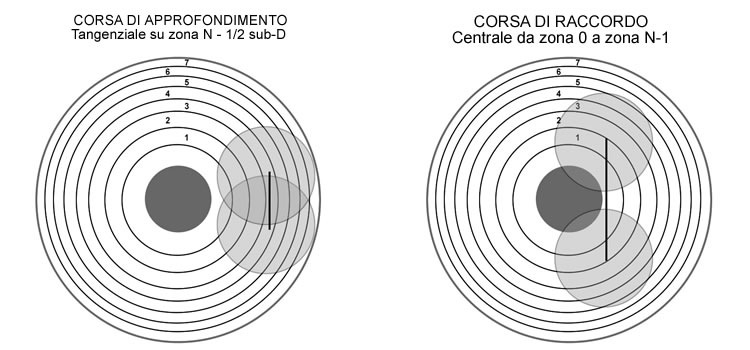
then passes to the N-1 zone, N-2… etc. until you get to the center. This is the sequence of tests after one-two sessions at most all performed with sub-utensil 105 mm ( 35% ) per 20-25 effective minutes per session.
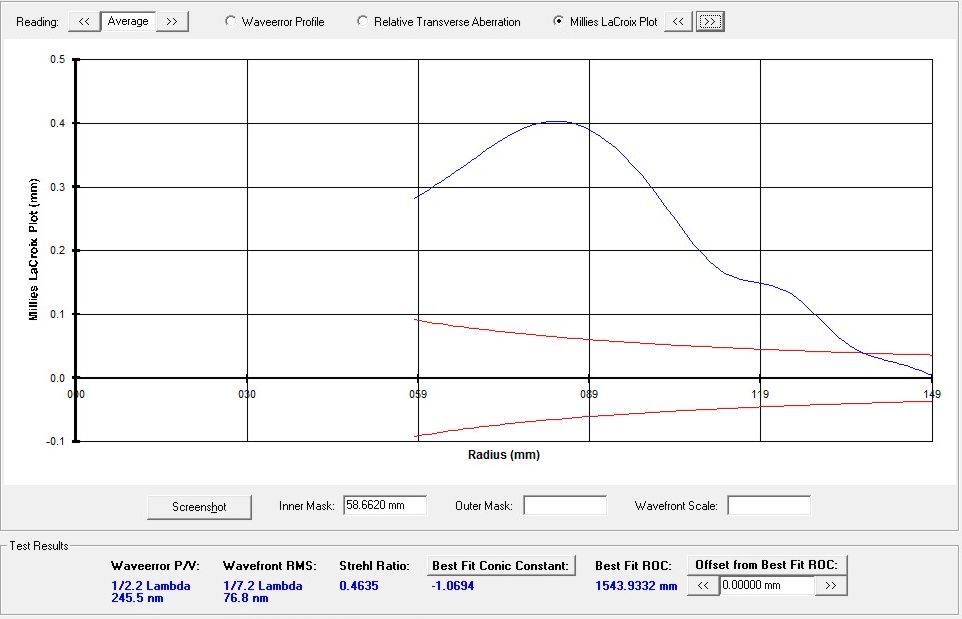
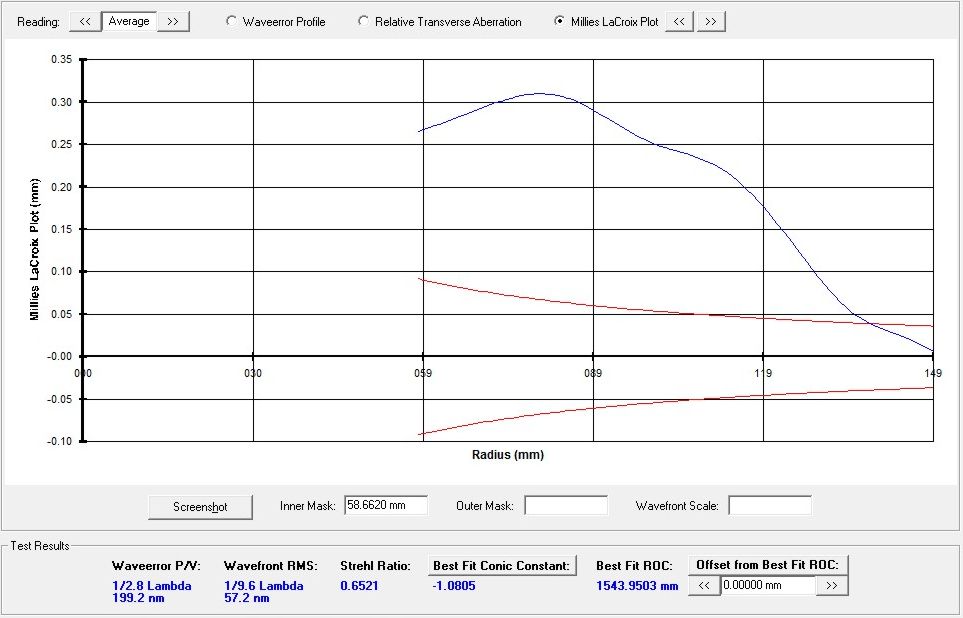
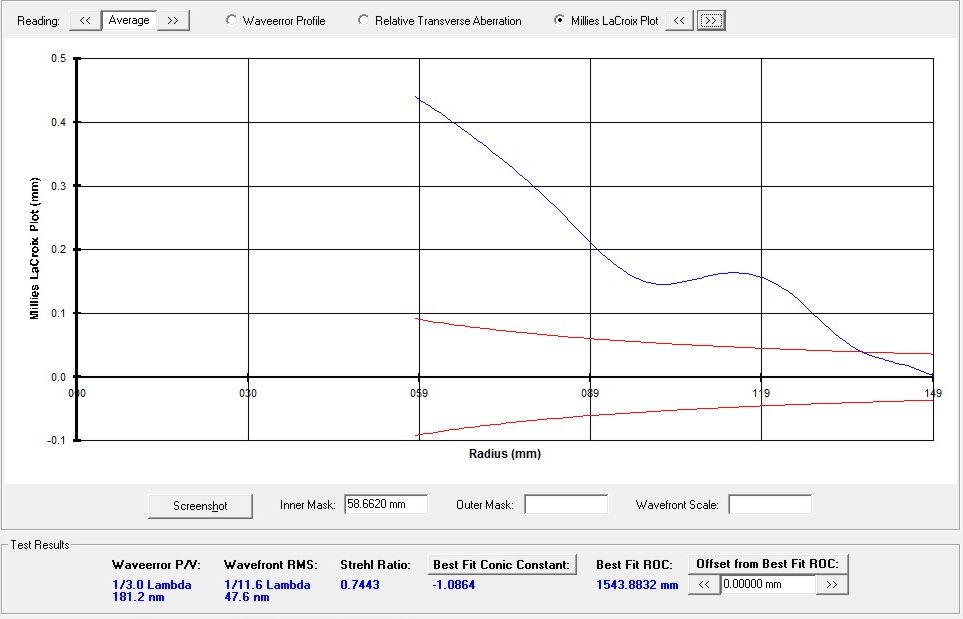

yet few laps to come within the “"trumpet bell"” working areas 4 2 0:
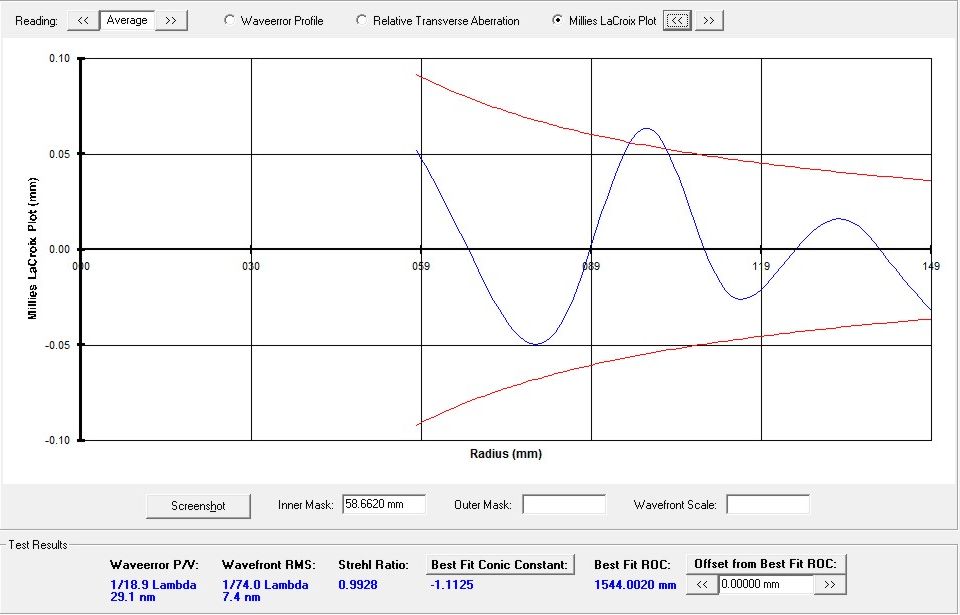
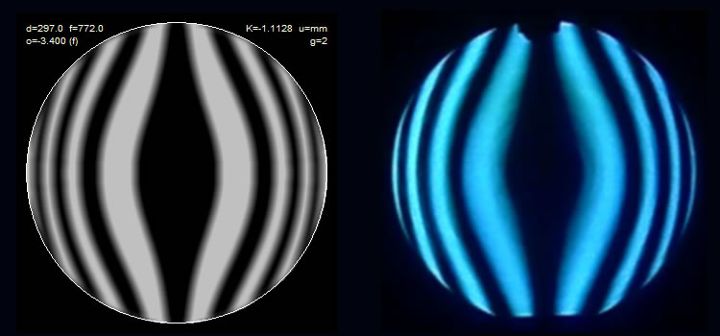
We finally constantly hyperbolic K=-1,1125 in practice it is to project, although it is not necessary to reach with extreme hyperbole precision designed, in the sense that in a Cassegrain system Ritchey-Chretien is the secondary that must be built on the primary, a different ( within limits ) Hyperbole may also be good, just dimensioned accordingly the secondary.
Do not be fooled by the value of lambda
 , This result is mainly realistic for two reasons:
, This result is mainly realistic for two reasons:1- I test con Foucault, like all the tests that measure the center of curvature on the optical axis, contain a basic error in the measurements , for the simple reason that in a paraboloid / iperboloide / ellipsoid the centers of curvature do not belong to the symmetry axis ( in this case optical ) but they are located on a surface of revolution , the infamous “caustic”, then at certain distances from the optical axis X increasing .
If for long focal lengths ( f6-f8) this approximation omits a negligible value ( but not zero ! ) for shorter focal assumes increasingly important values that can get to be above the range of tolerance, so in this case the lambda PV calculated Foucault has no credibility.
2- Foucault as we know, measuring a diameter, in my case measures 14 points in a diameter, but it tells us nothing about the rest of the surface. Just look at the Ronchi carefully and you find that there is some local defect that makes it clear that the accuracy of the area is still to be reached.
What is now important is to have reached in principle hyperbole certainly close to that desired, from now on, the measures will aim to go to intercept the center of curvature at its actual location, ie on the caustic of reflection , through its namesake tests that resituirà the coordinates X,Y of the center of curvature of the areas under consideration, providing a real result , reliable and much less subjective interpretation as.
It then starts with the construction of the new tester , for which I thank exaggeratedly Giulio
 who provided me with all the theoretical part / on the application of caustic tests, he personally translated from English and French. ( about Giulio, if I told / I tell some inaccuracy of this test, please correct me ! )7 June 2015 at 2:03 #6026
who provided me with all the theoretical part / on the application of caustic tests, he personally translated from English and French. ( about Giulio, if I told / I tell some inaccuracy of this test, please correct me ! )7 June 2015 at 2:03 #6026Many congratulations Massimo…look what work you've managed to do!!!!!!!!!!!!!!!

The lambda is perhaps a bit overstated, but I do not know how to tell the truth.
From what I read I seem to me that Gordon Waite Foucault uses to test its optical (which they are also low focal ratio) so if you did the test well ( and of this I am certain) I think that the test results are reliable enough.
In short, a great mirror…


 7 June 2015 at 22:29 #6028
7 June 2015 at 22:29 #6028Mirco, I thank you for the compliments, but are a little’ skeptical of these results and I agree with you that the lambda is overestimated:
Apart from the reasons already given there is also to consider other aspects:1- the measurement of the focal
I remember that I lost a Saturday afternoon to try to measure the center of curvature of the starting sphere with as accurately as possible, the measure of 1544 mm is the result of the average of the measurements, but a tolerance of at least 1 mm ( if not more ) the actual measurement must consider the nature of things. A millimeter of difference on the focal length is sufficient to halve the value of lambda, then if we add the deviation between the measurement optical axis and its actual position on caustic ( by a F2.6 !) here is that only with these two errors switching from an excellent mirror to a mediocre.2- accepted ( and even a little’ granted, I am more optimistic about this ) the goodness of the readings with Foucault, I still slightly inconsistent with the Ronchi test to Foucault. Surely it is difficult to judge from a single image, but running the Ronchi “live” I notice more than some local defects also a tendency to hyperbole undercorrection, I think it is not yet “secondary school certificate”, although it is not possible to have a quantitative measure Ronchi, the feeling is that we are still under ( slightly ) the conical constant resulting with Foucault.
3- the caustic test
I ran some simulations, and the result is not encouraging: the lateral displacement must be measured with centesimal precision, a difference of 1-2 hundredths of a mm produces significant variations on the calculated figure as it would produce a shift of 1-2 tenths on logitudinali readings.
Now, with all the self-esteem can, I doubt be able to build a tester that has mechanical play no more than one hundredth of a mm
Definitely , more I get, the more this seems a little hyperbole’ a leap in the dark, also thanks to the fact that there is no visual feedback can, It would not make sense to carry out a star test which would see the hyperbole as spherical aberration over a devastating coma soon as you move away from the optical axis.
So I am trying to think about what is the best way to finalize the primary with a minimum of certainty, also because a wrong evaluation of its parameters involves an incorrect sizing of the secondary and, at that point, fix the whole system would become very complicated… I would not this time ( as she told me “between the lines” astrotecnico some time ago ) have done “the longest leg of the step”… We hope not !

 8 June 2015 at 14:18 #6042
8 June 2015 at 14:18 #6042Oh yes Massimo, is a question the reliability of the results I have asked on several occasions even I.
Given the fact that the measurements there will always measurement uncertainties and that these amateur may be relevant for the calculation. I think it is really difficult to accurately measure surfaces with errors below a certain lambda.
As just one example, even with the test I thought was the most reliable among those who could use (or with interferometer Bath) you get different results using different photos of the same mirror, as explained here:
http://lnx.costruzioniottichezen.com/joomla/images/files_pdf/interferometria.pdf
So what to do?
I believe that for us amateurs, in addition to trying to make the testers with less possible games and use them properly we can only rely to a powerful mathematical tool (though often underestimated) or the Media…
Of course also the average can be trusted or not depending on the goodness of the input data data. That should make a pre-filtering of the measurements obtained to improve the quality of the input data using statistical methods, that I can not remember, but I try to go to search from all university notes.
Even in the test that I do I with the hartmann always it happens that between two different measurements I are different results with values of the draw of the areas which may vary even 2-4 tenths. To do this use 5-6 measurements and then take an average, although this time I'm looking for a way to make sure that with a little code in Visual Basic can take dozens of different images to make a more accurate average…Even if you do not know well how to do that…
 8 June 2015 at 18:49 #6044
8 June 2015 at 18:49 #6044From enthusiastic spectator of good work is that your Mirco, I must say that both are equally indicative of a good mastery of the corrective actions that you have put in a driving game with the result.
With regard to the finalization with a minimum of certainty, I trust that this will “approach” with the conduction of the caustic test.
After that test, present despite its flaws, He had an excellent baptism with the realization of the five-meter Palomar, and meter of “anni30” It was a purely mechanical device.
We know that having to do with tolerances of a few nanometers, we must resign ourselves to that certainty as such will never be attainable, but he can in turn be expressed only by a tolerance.
I thought comes to mind "philosophy" that you feel forced to accept when you're done working with a good mirror just F5, and at that juncture, while pursuing the fundamental make-up of many measures to reduce errors of drawing medium, still get different lambda values up to 4 or 5 unit.
At that point (and remembering that we speak of millionths of a millimeter) we must resign ourselves to feel good and finished the mirror that have met the criteria of Couder, It presents a lambda ranging for example from lambda / 8 to /12, as surely better than the minimum lambda / 8 found.
(The resignation also comes from the fact that an engineer or designer must constantly deal with the reality of approximations…errors that are only for accountants).
My thoughts would then be directed to cure the change of the Foucault tester so that especially on the transversal carriage is mechanically games.
It 's definitely hard to build the cross slide of the caustic tester so that it is no play, but it's close to a lot implementing the stratagem that I have experienced already on the longitudinal slide of my Foucault tester, holding it against the micrometer measurement with the shooting of an elastic, and having as the simple binary tube on which they support the TWO only shoes in the shape of an inverted V. (Also Cart cannibalized to a CD-rom drive, It is devoid of the game and at zero cost).
(The hype about a simple rubber band that reminds me of a famous brand of cars some time ago showed a driver who is following the trail of a creaking, I recover consciousness and eliminated oiling the earring of his beautiful. And in the auto industry to avert backlash that produce noise, many have learned how to build the body interior in such a way that the pieces "enter a little elastically forced" into their home).
I am convinced that this company will have a definitely positive outcome not only for Massimo, but to our knowledge that we will be pleasantly forced to continue to improve.
 9 June 2015 at 16:11 #6048
9 June 2015 at 16:11 #6048A few photos of the experiments made on the approach (..from afar ..) to the caustic test without pretension precision, but just to "realize when I realized"
 what does not work, or what I did not understand, and what surprises all.
what does not work, or what I did not understand, and what surprises all.
tester views 1
tester views 2
tester views 3
Setup generale
A Pseudo Couder 6 zones
B Pseudo Couder 6 zones
zone 4 in eame
zone 4 split because out of focus
zone 4 unique because it focuses (..not in the picture)
A-Mask 9 zones
B-mask 9 zonesAdd the filmatino of how moving the cart longitudinal images of 6 fenditire dates from 6 zones, flow from posiz.extrafocale, to a single image to the mirror fire, and more than slightly intrafocale (It spoiled by the fact that the camera mounted on a tripod apart, He did not follow the removal of the carriage from the lens).
Giulio, covering these pictures I think to be interpreted in this way:
pictured entitled “zone 4 unique because it focuses” what you see is the overlap on the optical axis of the reflections coming from the two holes in the area 4.
I'm not really focused, and the theory tells us that might not be , this is only the point in which the two light beams intersect, in practice the point where Foucault would see “the gray” uniform. In fact you have also noticed that the slit does not seem to fully focus.to find the fires of the two mirror portions under examination, we know to be distinct and do not overlap because the source is not infinitely, we have to search for them we move longitudinally and transversely, and find a very similar image with the previous:
“zone 4 split because out of focus”, It is actually split ( but with the slit defined ) just because it is ( or is very close ) the two fires that can not be superimposed on the optical axis, but they are detectable only on the caustic.
the distance that separates the two slits is precisely what we need to measure for the caustic test. as highlighted in the text you sent me:
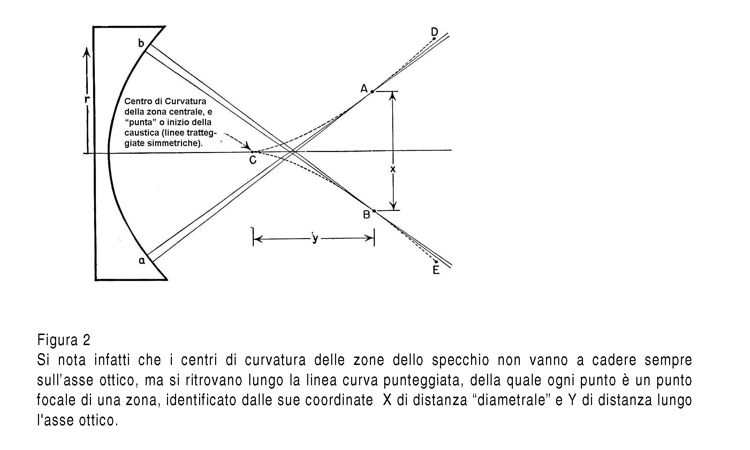
what do you think about it ?
9 June 2015 at 22:42 #6050TURNING-TESTER MODULAR

then, since they are better at destroying than building
 I decided to disassemble my mini-lathe from the living room and take a good tester for sodium:
I decided to disassemble my mini-lathe from the living room and take a good tester for sodium:
I discovered that this Emco 80s, is all easily removable modules, This is what came out: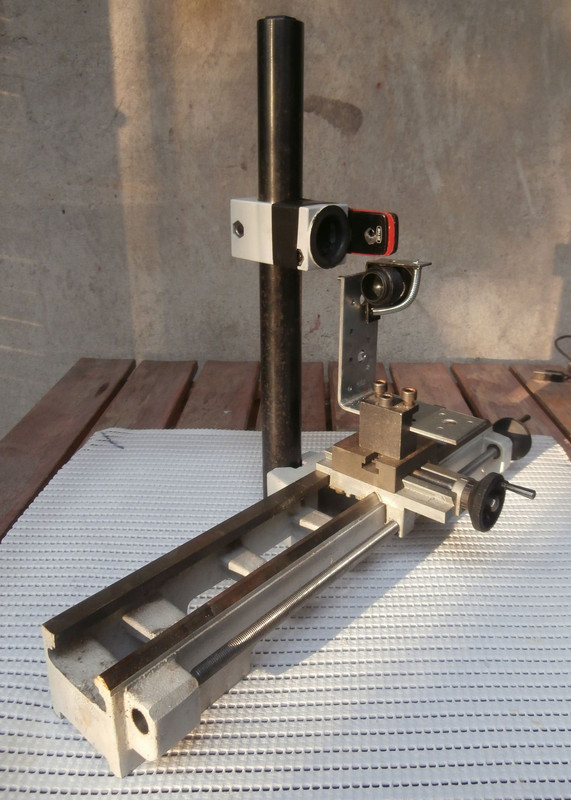
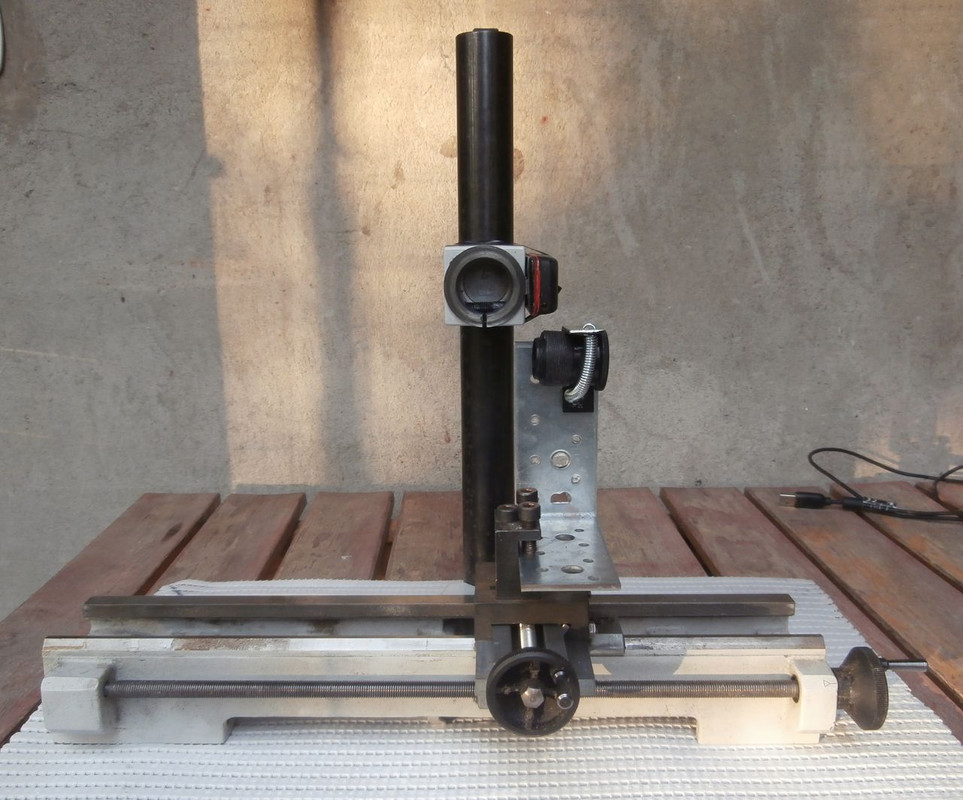
-Movements on two axes step 1 mm scale knobs
-bars and ground guides and precise movements
-height adjustable on the column
-all components are adjustable for a good alignment with the optical axis.
-total weight of 5 Kg in a length of only 36 cm, (if you kick you break a leg but he will not move )
) replacing the “block” eyepiece with the webcam, with a simple screw and nut, the tester to the caustic becomes the tester to Ronchi-Foucault.
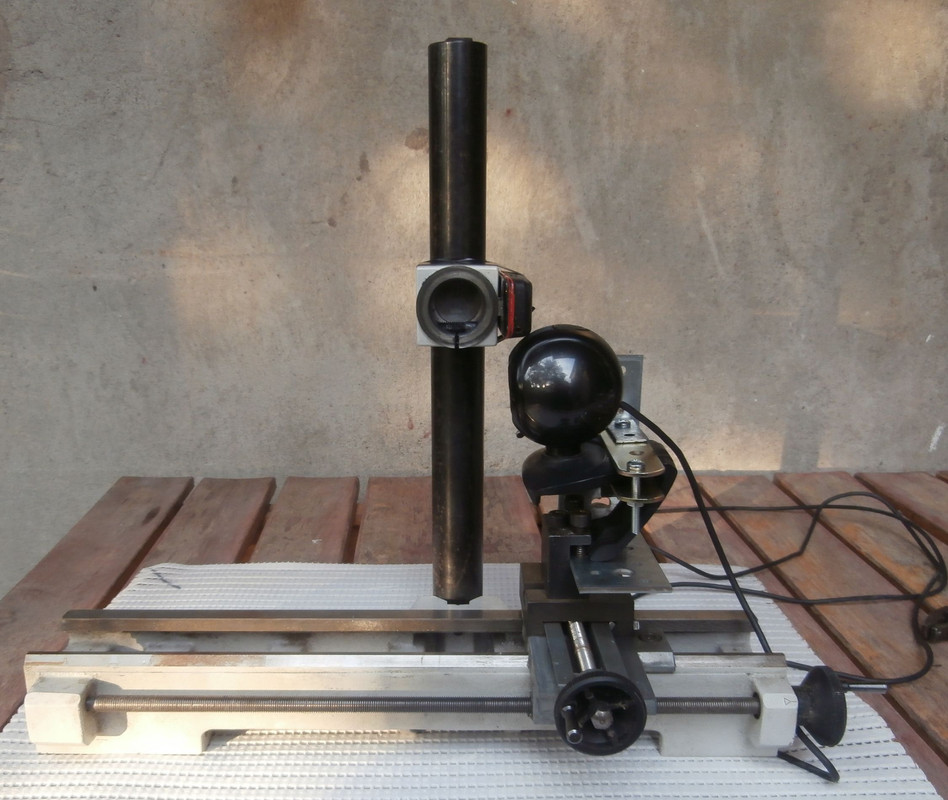
the knobs are easy to read 2,5 cents mm, ( the midpoint between two notches ) They are still too many, but I suspect that the grads measures can be made directly to the eyepiece, for example using a more stringent ocular, with the graduated scale similar to that of Julius microscope.
some photos in detail:
http://s26.postimg.cc/bqtsk4wih/tester_2.jpg
http://s26.postimg.cc/d0n0lg0wp/tester_4.jpg
http://s26.postimg.cc/p3sc90byx/tester_6.jpg
http://s26.postimg.cc/d4lfffvrt/tester_7.jpg10 June 2015 at 9:26 #6055I agree that the bad habit of my tests non the theory of caustic, is what you described. The problem for me was that my eye was not 9mm but 31, which does not allow a sufficient magnification, and I am therefore left in no doubt that the biggest problem is to be able to have a clear vision of the slit, to understand when it is clearly focused.
I see you have made a tester “militar rugged”, as they say to indicate a robust ultimate.
With that type of broad and robust construction, if you ever feel the lack, the eventual precision to a hundredth of reciprocal mechanical displacements, the you can read, for example, by inserting in the head of each slide a dial gauge for fifteen euro, with the mounting leg of its probe to touch the other sled in motion.11 June 2015 at 15:23 #6066Before the test session of Caustic performed with “military tester”.
Things are a bit’ different from what I thought:
– the extent of the lateral displacement is very simple, It does not need any paranormal powers of interpretation, Just take one of the two visible cracks on the center of the eyepiece crociccio, then move the carriage until the other image is not positioned in turn at the center and read the relative measurement. Since the slit is thin enough, it is easy to center it on the crossroads unambiguously. Read approximate measures to the penny is not at all complicated.-The extent of the longitudinal displacement is instead very complicated, the current state of my setup is unfeasible.
The problem with this reading is in the fact that the mask holes have a diameter of 15 mm and discover un'aera of mirror that has a radius of curvature ( means, medium ) of 1540 mm. In practice it is like looking at the eyepiece of an optical system to F 100 ! The longitudinal excursion in which the image it seems perfectly in focus it is of the order of 2-3 mm ! find the exact focal point is a company I think out of human possibilities ! I defy anyone to look at the eyepiece of a telescope F100 and find the focus point precise focus to the tenth of a millimeter.So there is something to fix, at the moment I am inclined to think that the width of the slit should be on the order of a few microns, in order to have the eyepiece a thin line, easier to focus.
However in doing so, the intensity of the light would be too low to allow a smooth vision.
I do not know… I have the impression that he is escaping me something 11 June 2015 at 19:32 #6070
11 June 2015 at 19:32 #6070I would think that the diametrro of the mask holes for the caustic test is indicated in R / 100 (that seems to be standard until the F3 focal rapporo the example of the book Lecleire…because in the American text focal they are F5 and even F8), R / 100 which are 30mm. Then for a mirror “depth” Double” as it is your, the diameter of the holes could be proven also a lot smaller, assuming that the diffraction fringes that arise around the holes due to the narrow slit (20 or 30 microns) They are not disturbing for the evaluation (since there is a webcam).
The drawback is that the areas to be measured becomes many!
Or, if the problems were to be debited to the focus of the slit, try to put the hair askew, as suggested brilliantly Mirco. -
AuthorPosts
- You must be logged in to reply to this topic.